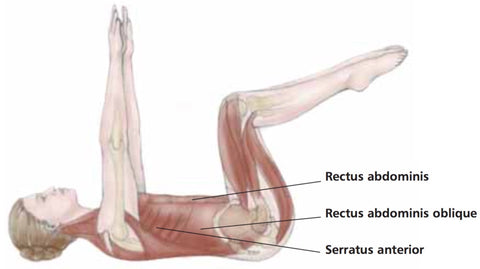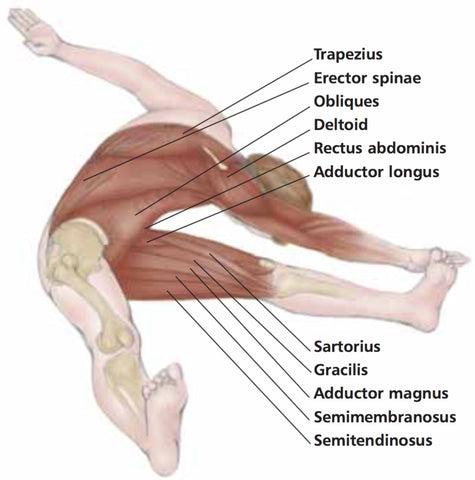Lower Back Pain - Strengthening the Abdominals
Rectus Abdominis Trigger Points - Dr. Jonathan Kuttner
Trigger Points - Where to Start?
The abdominals are mostly responsible for the health of the lower back
The abdominals are the main muscle group that flexes the lumbar and thoracic spine.
This is the action where the torso bends forward, or curls into the fetal position. If one does this against resistance, such as gravity, the muscles strengthen.
Each of the four abdominal muscles will be addressed separately below, but as a unit because of their location and attachment to the anterior portion of the spine, they are mostly responsible for the health of the lower back.

Rectus Abdominis
The rectus abdominis contracts to produce flexion of the spine because its fibers wrap around with the sheaths of the other abdominals laterally to posteriorly, therefore aiding the thoracic and lumbar areas.
Its main attachments anteriorly are on ribs 5 through 7 as well as the xyphoid process at the end of the sternum, and the pubis symphysis.
These attachment points are brought closer together when the muscle concentrically contracts.
This muscle is the most superficial (closest to the skin) and longest of the abdominals, so therefore the one that is “seen” the most. Its fibers run vertically and are striated in the upper portion, producing that infamous 6-pack look.
It is actually just a segmented appearance in the muscle fibers, seen mostly if a person is very lean.
To strengthen the rectus abdominis, perform exercises that will flex the spine against resistance, and perform them correctly.
Lie on the back and roll up, as in a sit-up, and the spine has flexed, with gravity as the resistance. Working against resistance is the most important aspect.

Stand with feet shoulder-width apart. Keep body upright and bend to the left or to the right. Can be performed sitting, kneeling, or standing, and is both a strength and stretch exercise for the abdominals. Arms overhead will add difficulty.

Lie on back (supine position) with knees bent, and feet on the floor. Flex the spine (always exhale when flexing) coming up halfway, and roll back down through each vertebrae on the “inhale”.

Lie on back, then flex the spine with the feet either on or off the floor, knees bent (legs straight and/or lowered is more advanced). Breathe!
External Obliques
This muscle lies under the rectus abdominis, not directly, but more lateral to it. When both left and right sides of the muscle contract together, it assists the rectus in flexion of the spine.
When one side contracts, it helps in lateral flexion (the right external oblique bends the spine to the right side, defined previously as ipsilateral). It is primarily a rotator of the spine contra-laterally (the right external oblique rotates the spine to the left, or opposite side).

Standing with arms out to sides, touch right hand to left ankle, stand up and repeat to other side. This will do all three actions of the external oblique, and provide both a strength and stretch exercise. It is mild because rotation is minimal against resistance – bend knees slightly to keep from hyperextending them.

Sitting straight with legs straddled about two feet apart, arms out to sides: rotate to the right, then bend forward, reaching the left hand toward the right foot. Exhale and deepen the stretch of the spine by pulling the abdominals against the spine. Return by rolling through spine to upright position and repeat on the opposite side.
Internal Obliques
Lying under the external oblique and at right angles to it, the internal oblique also aids in flexion of the spine, lateral flexion, and is a primary rotator.
When both sides contract (bilateral contraction), flexion happens; when one side contracts (unilateral), the resulting actions are lateral flexion and rotation.
The internal oblique rotates to the same side (right internal oblique rotates and laterally flexes the spine to the right) working ipsilaterally.

Lie face down and bring the hands close to the shoulders. Keep the hips on the ground, look forward and rise up by straightening the arms.
Transversus Abdominis
The transversus abdominis is the deepest abdominal muscle. Its muscle fibers run horizontally around the waist, hence the term “the waist cincher”, or girdle.
It attaches posteriorly (toward the back) to the thoraco-lumbar fascia, but does not work the spine in the usual sense.
It actually reduces the diameter of the abdomen, or ‘pulls the belly in’. This muscle can be felt when placing hands on the sides of the waist and coughing.
The transversus abdominis also attaches to the inguinal ligament (running from the anterior superior iliac spine to the pubic tubercle) and the iliac crest, both parts of the pelvic girdle.
This makes the transversus abdominis an extremely important muscle, due to the fact that it is a stabilizer of both the spine and the pelvis.
The best exercises for the transversus abdominis are ones that involve deep breathing. This muscle concentrically contracts when exhaling.
Forced expiration in any type of breathing exercise will activate the transversus abdominis.
Certain types of Yogic breathing, called pranayamas, are good examples. It can also be activated in any exercise, such as sit-ups and push-ups, by exhaling deeply when moving against gravity/resistance.

Lie on back, hands behind head without pulling on neck, elbows open; knees bent, feet on or off floor. Lift back a few inches off the floor, eyes to ceiling or abdominals. Move right elbow toward left knee, return to center, and repeat to the other side. Inhale on the twist, making sure the spine rotates as much as possible while hips remain stable; exhale in the center (always press abdominals toward spine while exhaling). This technique is ideal for all abdominals, especially the obliques.
Strength is Increased by Overloading
Repetition of the movement until fatigue is one of the best ways to overload the muscles being worked. Strength is increased by overloading. In Yoga, postures are held (isometric contraction) to create overload.
In Pilates and weight training, movement is repeated using concentric and eccentric contraction.
The speed of the repetitions is an individual choice, but be reminded that slower may actually be more beneficial; taking time to connect the mind with the body, working the correct muscles the right way and slowly, can exhaust the targeted muscles.
When the last movement is completed, it should be at a point of fatigue.
Seven points to keep in mind, for any age and level:
1. Any exercise that flexes the spine against resistance (gravity, weights, etc.), or laterally flexes the spine, will contract (work) the rectus abdominis.
2. A muscle needs to overload to increase strength – repetitions and sets are one of the best ways to do this, completing at least 8 repetitions in 2–3 sets, with fatigue the indicator of overload. (In Pilates, the emphasis is on slower and less repetitions, which can also tire the muscle.) Weight can be added to increase overload.
3. There is a right and left side to every muscle – work both sides equally.
4. Have strength and length as the goal – the desired appearance will happen eventually.
5. The 6-pack is defined by three tendinous intersections that the rectus fibers adhere to, which are visible as ‘grooves’ when the muscle contracts. If this look is desired, body fat must be on the lean side, and the muscle will most likely have to be ‘engaged’ to be seen.
6. BREATHE! Breathing is actually an exercise for all four abdominals.
7. ENJOY!
Find a Trigger Point Professional in your area
Dry Needling for Trigger Points
Certify as a Trigger Point Therapist
About NAT Courses:
As a manual therapist or exercise professional, there is only one way to expand your business - education!
Learning more skills increases the services that you offer and provides more opportunity for specialization.
Every NAT course is designed to build on what you already know, to empower you to treat more clients and grow your practice, with a minimal investment in time and money.
Best of all, we're always here to offer help and support.
Recommended Starter Packs:
This trigger point therapy blog is intended to be used for information purposes only and is not intended to be used for medical diagnosis or treatment or to substitute for a medical diagnosis and/or treatment rendered or prescribed by a physician or competent healthcare professional. This information is designed as educational material, but should not be taken as a recommendation for treatment of any particular person or patient. Always consult your physician if you think you need treatment or if you feel unwell.
About Niel Asher Education
Niel Asher Education (NAT Global Campus) is a globally recognised provider of high-quality professional learning for hands-on health and movement practitioners. Through an extensive catalogue of expert-led online courses, NAT delivers continuing education for massage therapists, supporting both newly qualified and highly experienced professionals with practical, clinically relevant training designed for real-world practice.
Beyond massage therapy, Niel Asher Education offers comprehensive continuing education for physical therapists, continuing education for athletic trainers, continuing education for chiropractors, and continuing education for rehabilitation professionals working across a wide range of clinical, sports, and wellness environments. Courses span manual therapy, movement, rehabilitation, pain management, integrative therapies, and practitioner self-care, with content presented by respected educators and clinicians from around the world.
Known for its high production values and practitioner-focused approach, Niel Asher Education emphasises clarity, practical application, and professional integrity. Its online learning model allows practitioners to study at their own pace while earning recognised certificates and maintaining ongoing professional development requirements, making continuing education accessible regardless of location or schedule.
Through partnerships with leading educational platforms and organisations worldwide, Niel Asher Education continues to expand access to trusted, high-quality continuing education for massage therapists, continuing education for physical therapists, continuing education for athletic trainers, continuing education for chiropractors, and continuing education for rehabilitation professionals, supporting lifelong learning and professional excellence across the global therapy community.

Continuing Professional Education
Looking for Massage Therapy CEUs, PT and ATC continuing education, chiropractic CE, or advanced manual therapy training? Explore our evidence-based online courses designed for hands-on professionals.



















